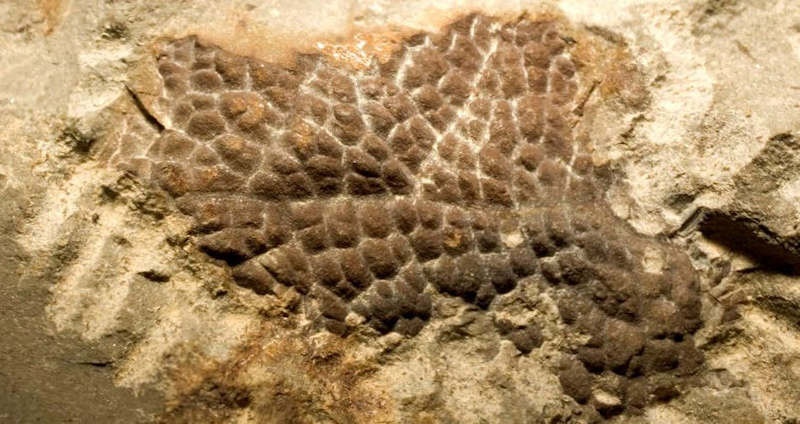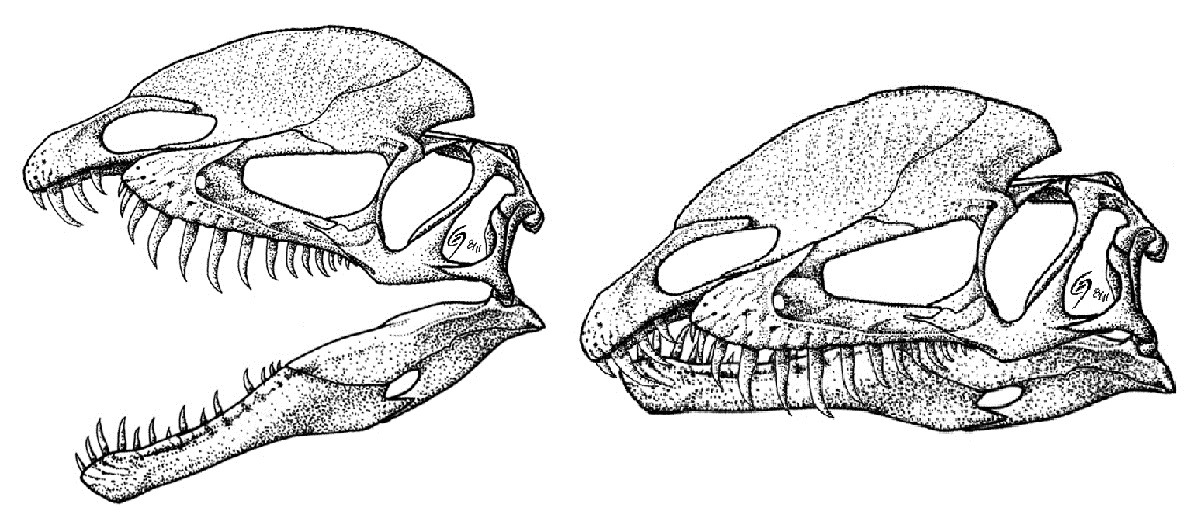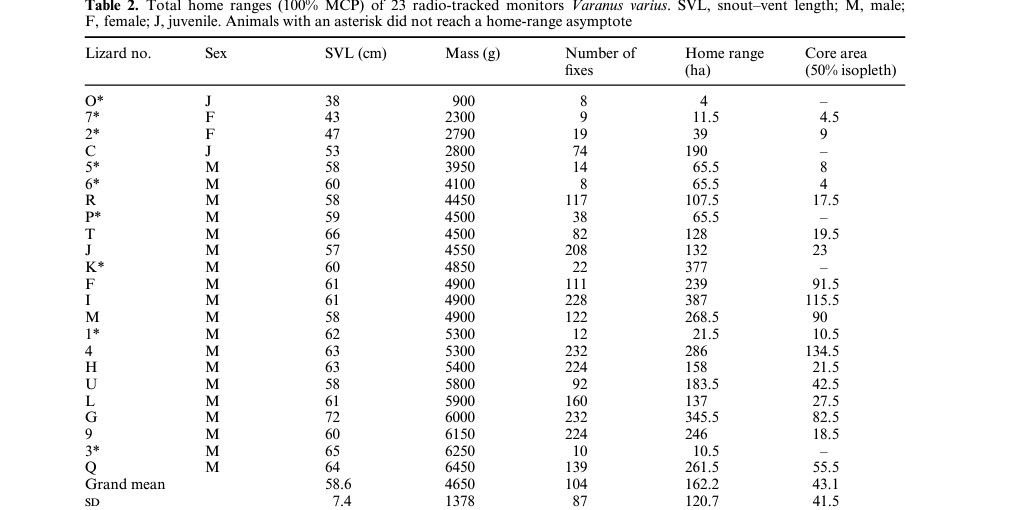|
|
Post by Infinity Blade on Nov 26, 2015 9:52:52 GMT 5
Um, what about the skin impressions of Wyrex? Aren't those considered scaly in a way?  Yes, but these are from the ventral side of the body. Even animals with feathers usually are featherless on the ventral side of their bodies. How large is that skin patch? I can't seem to find any of the papers describing it. They are nevertheless scales. So although we can be pretty much certain something like Tyrannosaurus had a lot of-if not perhaps most of-its body feathered, we do know some parts did indeed have scales, and it looked to me as if that one assertion in your post wasn't taking this into account. But eh, at this point I'm just telling you stuff you already know. |
|
Cross
Junior Member
  The biggest geek this side of the galaxy. Avatar is Dakotaraptor steini from Saurian.
The biggest geek this side of the galaxy. Avatar is Dakotaraptor steini from Saurian.
Posts: 266 
|
Post by Cross on Nov 26, 2015 11:00:59 GMT 5
Yes, but these are from the ventral side of the body. Even animals with feathers usually are featherless on the ventral side of their bodies. How large is that skin patch? I can't seem to find any of the papers describing it. They are nevertheless scales. So although we can be pretty much certain something like Tyrannosaurus had a lot of-if not perhaps most of-its body feathered, we do know some parts did indeed have scales, and it looked to me as if that one assertion in your post wasn't taking this into account. But eh, at this point I'm just telling you stuff you already know. I did use the term "Completely scaly". I indeed was envisioning a tyrannosaur with a protofeathery coat on its dorsolateral sides, while the ventral surface of its body was mostly scaly (I.E The abdomen and bottom of the tail). |
|
|
|
Post by Infinity Blade on Nov 27, 2015 8:02:37 GMT 5
Take note: I respond to the following as if I am engaged in an actual discussion. Obviously I'm not, but whatever. Wow, that's a really lofty assumption you've made there. Because we all know that a disbelief in soft tissue covering sharp teeth=fanboy.  In any case, yes, there actually is a legitimate case for a lack of "lips" in dinosaurs such as the Theropoda. It is as follows: 1.) although nutrient foramina are present on the jaws of theropods, they are also present on the jaws of birds and crocodilians, neither of which possess lips. 2.) furthermore, the size, distribution, number, and shape of theropod nutrient foramina don't seem to be quite like those of "lipped" creatures such as squamates (which are the main creatures theropods are compared to in this controversy). 3.) mammals, most of which have lips, also have foramina that are different from those any of the aforementioned clades. They don't appear to have a lot, and those that do exist are comparatively large. Likewise, some of the foramina may not even be in the lip area. Therefore, the whole nutrient foramina argument doesn't seem to hold water. 4.) some theropods had teeth that were simply too long for there to be lips. Some seem to have teeth that almost reach the bottom of the dentary and some even had teeth that go past the dentary (either way, significantly beyond the nutrient foramina). 5.) squamate skulls are not configured like those of theropods. In the former, the upper jaw seems to be more on top of the lower one, which would easily allow for lips to contact one another and whatnot. Such is not the case for theropods, which have a lower jaw slightly thinner than the upper one, allowing the former to sit snugly into the latter. In that case, the mandibular teeth would really have no use for lips at all, yet there are no animals with just lips on the upper portion of the skull. 6.) according to a recent SVP abstract (which I would guess wasn't published at the time what I'm responding to was written, so this is totally understandable), theropod skulls do not have the texture for lips, instead pointing towards tactile faces like those of crocodilians. One word: sabertooths. And unlike theropods, at least some sabertooths were animals that couldn't easily replace their teeth if something went wrong with the exposed dentition. Yet a lot of other (semi) aquatic animals possess soft tissue that seals the teeth (e.g. cetartiodactyls, pinnipeds, otters, and sirenians). If the water they live in supposedly keeps the inside of the mouth moist for them, then why didn't they lose their lips? Well...sure. What's next? Is that right? Even if that was indeed the case, your following premise still does not stand, as a.) I've already discussed how the dinosaurs that people love to gush over about their jaws and teeth have cranial & dental morphologies that contradict the presence of lips and b.) with this logic, you could also justify things like crocodilians having lips, which they don't (and I just refuted the "water keeps the mouth moist" argument, so no, you can't run to that either). Feathers look like fur (at least to some extent; some feathers seem to physically resemble fur more than others) and act like fur, so they are fur.  Again, that's because squamates have a cranial configuration that allows for this to happen, as I've explained above. "BIGGUR TEEF BEDDUR!!!!" Uhh, no, you've got it all wrong. Some theropods did indeed have respectably long teeth even with everything about the skull and teeth fixed as they would be in life, and it's only when you slap on lips that you get a problem between the two. And let's face it: overall, you didn't put up a very good argument for "lips" in theropods. tyra-rex.com/Dinosaur/Art/art.html |
|
Cross
Junior Member
  The biggest geek this side of the galaxy. Avatar is Dakotaraptor steini from Saurian.
The biggest geek this side of the galaxy. Avatar is Dakotaraptor steini from Saurian.
Posts: 266 
|
Post by Cross on Nov 27, 2015 11:11:29 GMT 5
Uhh, would the teeth be able to puncture as deeply if they had lips? I don't think so, and this is one of the reasons I find the lipped-theropod hypothesis implausible. This is coming from a hominid mammal who's tried to bite deeply into food before, and my lips always hinder my ability to sink my teeth deeply (particularly when I'm eating something like watermelon, chicken, or a burger).  |
|
|
|
Post by Ceratodromeus on Nov 27, 2015 12:11:58 GMT 5
I've done a lot of work regarding varanus sizes, mostly dealing with over exaggerations of adult animals' sizes; for example, this exchange on Carnivora I posted. Do note in this first instance, "Ackies" refer to the ridge-tailed monitor(V.acanthurus) ' My response: Yeah, no, most adult ackie monitors don't attain lengths close to 30in,let alone exceed them. The longest snout-vent length measurement i know is ~220mm(7.8in). That was from This paper(clickable) The tail is just as long,So the largest (that i know of) are probably around 440mm(~17.3in). and of course, we have to take into account that most individuals are going to be smaller then this. out of a sample of 36 animals,the mean snout-vent length measurement was 178.6mm(7.03in) with a standard deviation(+/-) of 30.6mm. Accounting for tail length, an average animal would be around the 300mm(11.8in) mark in this sample. However, also according to the above paper, the minimum adult snout-vent length is ~200mm(7.87in). Accounting for tail length, adults will measure ~400mm(15.7in). I do know of one paper suggesting the largest representatives of the species can attain lengths of 0.7meters(26in), which seems plausible. Another good example The wikipedia pages state a 20+kg figure for both the perentie(V.giganteus) and lace monitor((V.varius) for an upper end to their mass, without any citations. So after quite a bit of digging, I came across Varanoid lizards of the world -- which gives the highest recorded masses for the parents and Lacie at ~17kg and ~14kg respectively. The latter species' ~14kg figure is also reported in a lot of scientific literature. More on the Lacie, I come across this alot: This one always gives me a good laugh, and the data I provide is as follows First table is of radiotelemetry on the species  And this one too, though it does show adult males are fairly large, it is still short of the 10kg figure  This one is a classic. I made this reply far before I could figure out screenshotting, but should suffice in debunking the above that is still on wikipedia "Comparative morphology of Western Australian varanid lizards(squamata: Varanidae)." Gives a total body length for mature animals at anywhere from 600-650mm(1.9-2.3ft) I'd also like to note that ~6kg for the sand monitor is likely an unfounded claim, and maybe confused for the Argus monitor( V.panoptes) which has been documented growing to ~6kg. The claim of a ~6kg V.gouldii individual is further muddied when the wikipedia page does not give a reference for this statement. The highest mass figure I could find for the species was 1.5-2kg, ( Varanoid lizards of the world)and probably represents the maximum size for the species. The following screenshot (from "Activity area during the breeding season of Varanus gouldii (Reptilia: Varanidae) in an urban environment.")Validates only large animals will crack the 1kg mark  The above is not the largest sample of individuals, but you get the general idea there. That's all for now, I'll post more sooner or later. |
|
Cross
Junior Member
  The biggest geek this side of the galaxy. Avatar is Dakotaraptor steini from Saurian.
The biggest geek this side of the galaxy. Avatar is Dakotaraptor steini from Saurian.
Posts: 266 
|
Post by Cross on Dec 4, 2015 11:10:32 GMT 5
The following will deal with claims made by Spinosaurus fanboys regarding its anatomy, body size, and diet.
Since I don't have enough time to track down all the quotes one by one, I will simply paraphrase the claims they make.
Number 1, "confirmed" is a strong word. A long-legged Spinosaurus has never been confirmed either, since we simply based it on phylogenetic bracketing.
Second, given the number of times it was demonstrated that Spinosaurus B and the 2014 neotype overlap in almost every detail down to the shape of the vertebrae and the morphology and proportions of the femora, then the most parsimonious assumption would be that both specimens represent what the animal had actually looked like.
Again, refer to number 1. Both specimens are nearly identical in proportions and osteology, down to the concave and elongate centra of the dorsals and the narrow femora along with the flattened pedal phalanges and unguals. The only way that the two specimens can be chimaeras is if, by some miraculous feat of nature, the sediments of North Africa managed to arrange a random assortment of bones into the exact same pattern twice in a row, 80 years apart.
As far as I know, there are around 7 described species of Spinosaurids. They are :
Baryonyx walkeri, Suchomimus tenerensis, Ichthyovenator laosensis, Siamosaurus suteethorni, Irritator challengeri, Oxalaia quilombensis, and Spinosaurus aegyptiacus. Only 3 out of those 7 species are known from associated hind limb material that shows plesiomorphic hind limb proportions, while the other 4 are known from either short legs, or no legs at all. It is therefore, within the realm of possibility, that Irritator and Oxalaia also possess reduced hind limbs given their phylogenetic proximity to Spinosaurus.
Firstly, only the cervical vertebrae have been referred to Sigilmassaurus. Just because the cervicals belonged to a potentially different species does not mean that the entire reconstruction is now wrong. It just means that we don't know the proportions of its neck anymore, but the pelvis and hind limbs as well as the dorsals and skull fragments still hold.
For example, the skull of the holotype Apatosaurus was based on Camarasaurus, but only the skull. No one at the time seriously suggested that the entire Apatosaurus specimen must have been a chimaera, since it was only the skull that was the problem.
Plus, Andrea Cau has even demonstrated that Sigilmassasaurus may not be a distinct genus at all, but merely a second species of Spinosaurus. Sigilmassasaurus is not known from any hind limb material either, so you know where this is going.
Giant physteroid whales are literally over 5 times larger than Spinosaurus, yet they survive entirely on soft bodied cephalopods and other aquatic vertebrates. Plus, the fish that Spinosaurus hunted varied in size from ~4 meter long giant Actinistians such as Mawsonia, to 8-meter long Chondrichthyans weighing over 2.5 tons such as Onchopristis numidus. So the whole "It's too big to sustain itself on fish only" argument is stupid.
Plus, if Spinosaurus was indeed a predator of large, terrestrial animals, then we should expect it to have similar adaptations to predators of large prey. Such as : ziphodont dentition, a robust, oreinorostral skull, laterally wide jaws, and a muscular neck. Spinosaurus has none of these, and its prey-acquisition adaptations are similar to those of modern fisher birds and piscivorous Ghavials.
There's also its alleged capability to swipe its forelimbs like a bear, and that it is apparently faster than a T. rex, but those can wait.
|
|
|
|
Post by Infinity Blade on Dec 7, 2015 7:38:49 GMT 5
Speaking of bears and arm swipes (my replies are in orange):
|
|
|
|
Post by Infinity Blade on Dec 8, 2015 8:47:49 GMT 5
There was a thread on Carnivora that Mantrid created about Spinosaurus and whatnot. In that thread, some user made some claims, I went on to try and refute them, then I went in for a second shot, as I felt my first replies weren't really that in depth. The only thing I changed were the emoticons and replaced them with similar ones on here (as Carnivora's emoticons obviously don't work here).
|
|
Cross
Junior Member
  The biggest geek this side of the galaxy. Avatar is Dakotaraptor steini from Saurian.
The biggest geek this side of the galaxy. Avatar is Dakotaraptor steini from Saurian.
Posts: 266 
|
Post by Cross on Dec 8, 2015 11:33:56 GMT 5
Since you brought up the idea of revisiting one's own rebuttals in order to find a way to make them more in-depth, I think I'll do so right now.
AFGThugonomics claimed this (the following is simply a paraphrasing of what he said) :
And he says this in a nonchalant manner, as if to imply that everyone else is automatically blind and ignorant to not realize that using the bones of other relatives to complete a reconstruction automatically makes that said reconstruction a chimaera.
Now, he does have somewhat of a point, but based on my experience with him, he uses a very loose definition of the word "Chimaera". In paleontology, the term is used to refer to an animal specimen found in matrix that is actually comprised of the bones of multiple different animals. It's not used to refer to a reconstruction based on phylogenetic bracketing where the proportions of an animal are inferred based on more complete relatives.
And that's exactly my point. Spinosaurus is not the only animal with which most of its propo
rtions were inferred based on phylogenetic bracketing. Paleontologists do this literally all the time with other species. Scott Hartman's skeletal of Puertasaurus reuili, for example, is actually just 1-2% based on the known material and 98% of it is based on Futalognkosaurus dukei. His skeletal of Giganotosaurus is actually just a composite of the holotype specimen in an articulated pose with most of the skull and vertebrae based heavily on Mapusaurus and Tyrannotitan.
If anything, the 2003-2013 reconstructions of Spinosaurus such as the one in Planet Dinosaur is more deserving of the title "Chimaera" since those reconstructions were just based on the fragmentary MSNMv-4047 and IPHG (BSP) 1912 VIII 19, while 80% of it was just inferred and scaled up from Baryonyx, Suchomimus, and Irritator.
This is an Appeal to Majority fallacy. I.E The structuring of the argument is a simple
"Everyone is doing X, therefore, X must be true *proceeds to completely reject idea Y*"
We have evidence of hind limb reduction in 2 specimens of Spinosaurus, and no evidence for any long-legged members of this genus exist. It's not out of the question for Spinosaurus to be an exception to the plesiomorphic state of spinosaurids. There are many clades of animals where one of the most derived taxa of that lineage show exceptions to the plesiomorphic state of the clade (e.g Naked primates, limbless tetrapods, armored sauropods, bone-crushing mosasaurs).
Just for the record, I could go on rebutting his Ad Homimem, Ad Ignorantium, Red Herring, Strawman, and Argentum ad numeram fallacies since this AFGThugonomics guy is the personification of logical fallacies. The dude is a walking logical fallacy, based on my experience with him. But I don't have the time nor the commitment to write an extremely long rebuttal and post it here.
|
|
|
|
Post by creature386 on Dec 8, 2015 20:02:06 GMT 5
The ironical part is that there are indeed claims of Ibrahim et al.'s reconstruction being based on a chimera (although completely different from his description), but as the ontological stage of both animals is likely the same and Nizar Ibrahim explained why the chimera is unlikely in a comment under Hartman's blog, this is obviously no argument to ignore all recent evidence and to stick dogmatically to the old Spinosaurus.
Nice rebuttals of course guys.
|
|
|
|
Post by Venomous Dragon on Dec 9, 2015 11:04:35 GMT 5
Uhh, would the teeth be able to puncture as deeply if they had lips? I don't think so, and this is one of the reasons I find the lipped-theropod hypothesis implausible. This is coming from a hominid mammal who's tried to bite deeply into food before, and my lips always hinder my ability to sink my teeth deeply (particularly when I'm eating something like watermelon, chicken, or a burger).  I'm not saying theropods had lips but the idea that lips would prevent them from biting deeply into their prey is pretty hilarious. Lips are not the reason you can't bite deeply into food items it's your dentition and jaw morphology that limit your ability to bite deeply. Dogs have lips and don't have this problem Cats have lips and don't have this problem Lizards have lips and don't have this problem etc etc etc |
|
Cross
Junior Member
  The biggest geek this side of the galaxy. Avatar is Dakotaraptor steini from Saurian.
The biggest geek this side of the galaxy. Avatar is Dakotaraptor steini from Saurian.
Posts: 266 
|
Post by Cross on Dec 9, 2015 11:22:23 GMT 5
Uhh, would the teeth be able to puncture as deeply if they had lips? I don't think so, and this is one of the reasons I find the lipped-theropod hypothesis implausible. This is coming from a hominid mammal who's tried to bite deeply into food before, and my lips always hinder my ability to sink my teeth deeply (particularly when I'm eating something like watermelon, chicken, or a burger).  I'm not saying theropods had lips but the idea that lips would prevent them from biting deeply into their prey is pretty hilarious. Lips are not the reason you can't bite deeply into food items it's your dentition and jaw morphology that limit your ability to bite deeply. Dogs have lips and don't have this problem Cats have lips and don't have this problem Lizards have lips and don't have this problem etc etc etc Oh...yeah, that's probably why I can't bite deeply into food. Well, this is embarrassing....  |
|
|
|
Post by Infinity Blade on Dec 10, 2015 3:25:07 GMT 5
More hogwash from the guy I previously refuted.
Me:
His reply:
And here's my response:
|
|
|
|
Post by creature386 on Dec 12, 2015 2:33:50 GMT 5
I am wondering if anything from Asadas would fit here (as he is really annoying on carnivora right now), but I doubt it for two reasons:
1. His claims are getting debunked all the time.
2. They'd rather fit in a thread about not even wrong answers.
|
|
|
|
Post by Ceratodromeus on Dec 12, 2015 7:35:52 GMT 5
Um, what about the skin impressions of Wyrex? Aren't those considered scaly in a way?  Yes, but these are from the ventral side of the body. Even animals with feathers usually are featherless on the ventral side of their bodies. How large is that skin patch? I can't seem to find any of the papers describing it. "Even animals with feathers usually are featherless on the ventral side of their bodies." You sure about that one?   |
|